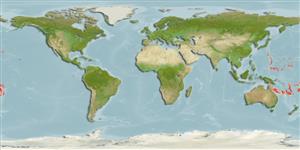Environment: milieu / climate zone / depth range / distribution range
Ecologie
marien; zoet water; brak water demersaal; amfidroom (Ref. 51037); diepte 1 - 1000 m (Ref. 58302). Tropical; 30°N - 25°S, 140°E - 160°W
Oceania: Mariana Islands south to Vanuatu, New Caledonia and Fiji.
Lengte bij maturiteit / Grootte / Gewicht / Leeftijd
Maturity: Lm ?, range 7 - ? cm
Max length : 24.5 cm SL mannelijk / geslacht onbekend; (Ref. 26668); 16.5 cm (female)
Benthic (Ref. 58302). Adults occur from lowland streams and rivers to relatively swift streams at elevations of 1000 m. They often burrow into the substrate with only the eyes showing; feed on filamentous algae, worms, crustaceans, various insects and insects larvae, and suspended food particles; has been long favored as food by the early Hawaiians (Ref. 44091). Larvae develop and metamorphose in the marine zooplankton and as juveniles, about 161 days old, recruit to freshwater streams, where they undergo rapid growth and morphological changes necessary for upstream migration to the adult habitat (Ref. 51037).
Levenscyclus en paargedrag
Maturiteit | Voortplanting | Paaien | Eieren | Fecunditeit | Larven
Adults move downstream to their prime breeding just above the estuary; males select crevices and caves formed by rocks on the stream bed where the females will lay their eggs; males guard nests until larvae hatch a day later (Ref. 44091).
Watson, R.E., 1992. A review of the gobiid fish genus Awaous from insular streams of the Pacific Plate. Ichthyol. Explor. Freshwat. 3(2):161-176. (Ref. 26668)
Status op de Rode Lijst van het IUCN (Ref. 130435)
Gevaar voor de mens
Harmless
Gebruik door de mens
Meer informatie
ReferentiesAquacultuurAquacultuurprofielKweeklijnenGeneticaElectrophoresesErfelijkheidZiektesVerwerkingNutrientsMassaconversie
Tools
Speciale rapporten
Download XML
Internetbronnen
Estimates based on models
Preferred temperature (Ref.
123201): 9.2 - 23.2, mean 15.6 °C (based on 54 cells).
Fylogenetische diversiteitsindex (Ref.
82804): PD
50 = 0.5000 [Uniqueness, from 0.5 = low to 2.0 = high].
Bayesian length-weight: a=0.01122 (0.00570 - 0.02208), b=3.11 (2.95 - 3.27), in cm total length, based on LWR estimates for this species & Genus-body shape (Ref.
93245).
Trofisch niveau (Ref.
69278): 2.2 ±0.1 se; based on diet studies.
Weerstandsvermogen (Ref.
120179): Gemiddeld, minimale populatieverdubbelingstijd 1,4-4,4 jaar (Assuming tm=1-2 and Fec<1000).
Fishing Vulnerability (Ref.
59153): Low vulnerability (11 of 100).
